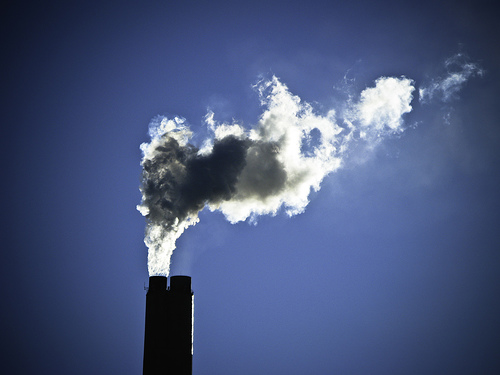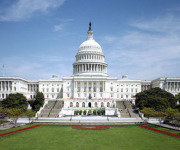 Photo: Nick HumphriesCross-posted from the World Resources Institute. This piece was written by WRI Senior Fellow Franz Litz and WRI Senior Associate Nicholas Bianco for a WRI series on the EPA regulations.
Photo: Nick HumphriesCross-posted from the World Resources Institute. This piece was written by WRI Senior Fellow Franz Litz and WRI Senior Associate Nicholas Bianco for a WRI series on the EPA regulations.
With climate change legislation stalled in Congress, all eyes have turned to the Environmental Protection Agency for emissions reductions. According to our recent report, “Reducing Greenhouse Gas Emissions Using Existing Federal Authorities and State Action,” the EPA can make significant progress to reduce emissions through implementation of measures under the existing Clean Air Act. Yet the prospect of EPA action has caused some in Congress and industry to express fears that EPA will go too far by imposing unreasonable regulations to reduce greenhouse gas emissions. Given the built-in limitations on EPA authority contained in the Clean Air Act, these fears are misplaced.
Laws require the EPA to act reasonably
The EPA has no more regulatory authority than Congress has granted it. Congress created the Environmental Protection Agency and legislated the Clean Air Act. Congress has amended the Clean Air Act multiple times over its 40-year history. In the Clean Air Act, Congress established limitations on EPA’s regulatory power, requiring it to consider the cost of regulation and its other impacts. Federal courts have, in turn, applied the Constitution to impose a standard of reasonableness on the EPA. In other words, the EPA is required by law to be reasonable and to act within the bounds Congress established.
Examples of already built-in constraints on the EPA
Best Available Control Technology: The Clean Air Act is replete with restraints on EPA authority. Take, for instance, the permitting requirements that will go into effect on new and modified large power plants and industrial facilities at the start of 2011. The Clean Air Act requires that these new and modified facilities install the Best Available Control Technology (BACT) to control greenhouse gas emissions. In determining what constitutes BACT for a specific facility, the law requires EPA or the delegated state permitting authority to take into account “energy, environmental and economic impacts and other costs.” EPA is expected to release a guidance document detailing how this BACT determination will be made for greenhouse gas emissions. In general, though, BACT determinations could require that a plant maximize its carbon efficiency (e.g., by installing a more efficient turbine) or install a control technology. If the sponsor of a proposed facility believes that the permitting authority has failed to reasonably account for these costs, then the sponsor may appeal the permitting decision and ultimately seek judicial review.
New Source Performance Standards: The other provision of the Clean Air Act the EPA is expected to rely on to reduce greenhouse gas emissions from large power plants and industrial facilities (section 111 of the act) likewise constrains EPA’s regulatory power. Under section 111, EPA establishes New Source Performance Standards (NSPS) for new facilities within specified categories of emission sources such as refineries, cement kilns, and power plants. The NSPS requirements must be set based on the “best system of emission reduction” that has been adequately demonstrated in practice, and the EPA must “take into account the cost of achieving such reduction and any nonair quality health and environmental impact and energy requirements.” Under subsection (d) of section 111, states regulate existing sources of greenhouse gas emissions, and in so doing they must consider cost, non-air-quality health and environmental impact and energy requirements, as well as the remaining useful life of the existing power plant or industrial source. The current regulation of landfills under section 111 provides an example of how section 111 would work: Large landfills must ensure that air emissions of a variety of organic compounds are limited in order to protect public health and prevent fire and explosions. This is typically done through capture and destruction of those compounds.
Federal court oversight
Aside from the restraints imposed on the EPA by the statutory language of the Clean Air Act, federal courts will review EPA regulatory actions to ensure that the agency has not exceeded its statutory authority and has not acted arbitrarily or capriciously. Federal courts serve as a check to the administration’s authority by ensuring that the EPA does not act unreasonably. This reflects the legal reality that EPA has no greater authority than the law vests in the agency. And while the courts will generally defer to the agency’s reasonable interpretation of the Clean Air Act, they have also set aside agency rules when they were found to extend beyond the statutory boundaries established by Congress.
Congress has prescribed specific limitations on the EPA’s authority, and the courts exist to ensure that EPA acts within the boundaries of the law. These limitations on the EPA should give policymakers confidence that the EPA will, and must, act within its boundaries to protect human health and the environment.
The Tailoring Rule: the role of practical constraints
In addition to the legal constraints on EPA contained in the Clean Air Act and enforced by the federal courts, significant practical constraints operate to ensure that EPA acts reasonably. The recently issued “Tailoring Rule” illustrates the role of practical constraints. EPA decided that it would be unworkable to apply the Clean Air Act to all facilities that could be covered under the law by pre-construction permitting requirements. Citing “administrative necessity,” the EPA issued the rule to limit what facilities will be covered to only very large greenhouse gas emitters such as new and modified power plants and industrial facilities. Thus, practical constraints led to more reasonable action by the EPA, and small businesses, like the proverbial “mom & pop grocery,” remain unaffected by the regulations.
Given the constraints on the EPA’s authority already built into the Clean Air Act, the role of the courts to ensure that EPA operates within these constraints, based on previous experience of regulations, and the practical realities of regulating greenhouse gases, we can expect the EPA to proceed in a reasonable fashion.



